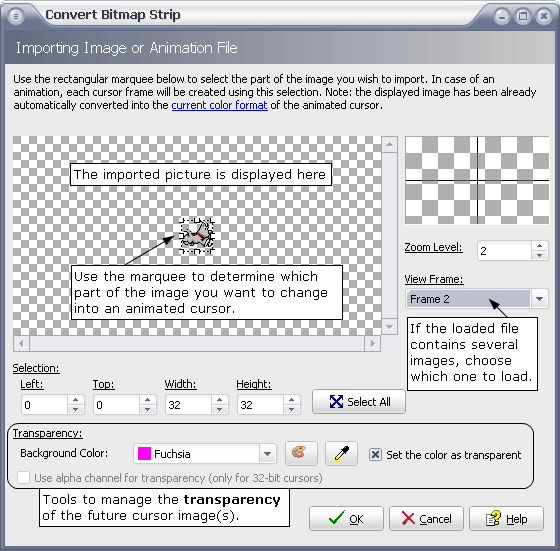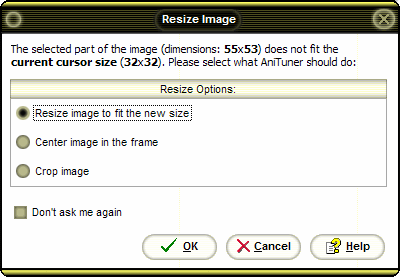Since AniTuner does not feature its own image editor, it is able to import existing image files and transform them into animated cursor frames.
You can import images by clicking "Import Image(s)" in the "Edit Cursor Frames" page or in the "Edit Frame" dialog box.
To make up for the lack of an image editor, AniTuner recognizes the following image formats:
- Bitmap (.bmp).
- JPEG (.jpg).
- PNG (.png) including their alpha channel if any (see below).
- GIF (.gif) - static or animated. Multiple images (frames).
- Adobe Photoshop (.psd) (all layers are merged, alpha channel handled).
- cursor (.cur), static Windows cursors. Multiple images.
- icon (.ico). Multiple images.
- animated cursor (.ani). Multiple images (frames).
- Video for Windows (.avi). Multiple images (frames).
Steps to import an image
![]() Select the image file you want to import and AniTuner shows you the following dialog box.
Select the image file you want to import and AniTuner shows you the following dialog box.
Note that if you select several image files, the "Import image" dialog box will be displayed for each image.

- If the imported image file contains several sub-images (case of icons, cursors, AVI, animated GIF), you may select the frame to import using "View Frame" as shown on this screenshot.
- If the imported image format supports transparency (like GIF, icons, cursors, Photoshop files), AniTuner tries to find out the background color and configure it so it becomes the transparent (on this screenshot this is fuchsia). More details about transparency below.
![]() An image may not fit the dimensions of the animated cursor, so you need to indicate which part of the image you want to import as the new frame.
An image may not fit the dimensions of the animated cursor, so you need to indicate which part of the image you want to import as the new frame.
Use the marquee and its eight boxes to select the part of the image, or directly enter the coordinates (Left-Top-Width-Height) in the four corresponding fields for the selection rectangle.
![]() If the selection still does not fit the dimensions, AniTuner will prompt you for the resizing method it should use to correct this:
If the selection still does not fit the dimensions, AniTuner will prompt you for the resizing method it should use to correct this:

- Resize image to fit the new size: this will resample the old image to fit the cursor frame.
- Center image: the frame background will be first resized to the new size and the old image will then be drawn as centered in the new frame.
- Crop image: the frame background will be first resized to the new size and the old image will then be drawn at the top-left corner of the new frame.
Make your choice and press OK to continue.
![]() A magnifying glass is available on the right: it shows a zoomed version of the pixels near your mouse pointer. This may be useful when you make the selection using the mouse.
A magnifying glass is available on the right: it shows a zoomed version of the pixels near your mouse pointer. This may be useful when you make the selection using the mouse.
About the color depth
Imported images may not have the same color depth as the animated cursor. In this case, AniTuner always first converts the imported image to the animated cursor's color depth before creating the frame. For instance, if your imported image has 24 bpp (true colors) and your cursor has 8 bpp only, AniTuner will perform a color reduction from 24-bit to 8-bit (a color reduction generally leads to a quality loss).
Image transparency
The background color is used in bitmaps to represent the regions that appear as transparent in the animated cursor. When creating the animated cursor's frames, AniTuner generates a mask by using this background color to determine the parts of the image that need to be masked (i.e. made transparent).
You can visually select the color to set as transparent using the dropper tool:![]() . Click on the pixel of the image you want its color to become the background one.
. Click on the pixel of the image you want its color to become the background one.
You may also set no transparency for this image, but this is not recommended as the frame will not be transparent at all (animated cursors should always have a transparent area). To set no transparency, uncheck "Set the color as transparent" option.
Use alpha channel or not for 32-bit cursors
32-bit animated cursors contains an alpha channel which plays the role of the mask. It specifies how the pixel's colors should be merged with another pixel when the two are overlaid, one on top of the other.
For PNG, icon, cursor and Photoshop PSD files, the alpha channel is recognized by AniTuner. In this case, the "Use alpha channel" option will be enabled: leave it checked and the alpha channel will be imported too when creating the frame. Otherwise, the alpha channel is ignored and a new one is created as described below.
If you import a picture that is not already in the 32-bit format, AniTuner creates an alpha channel based on the mask that you can modify later using the tools in the "Edit frame" dialog.